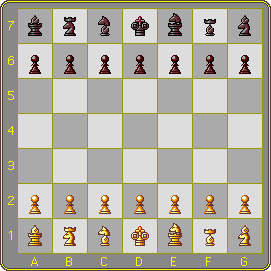 | I could argue that Dragonfly was a premeditated attempt to merge the ideas in western Chess with those in Japanese Shogi, and get away with it. But it wasn't like that. At some point in the late seventies or early eighties, when pondering the western pawn's unique properties, I asked myself this question: 'what if, in a chess game, all pieces except the king would capture differently from the way they move' ? This resulted in Loonybird |
 | In Loonybird the bottom part of a piece indicates how it moves, the top part how it captures. Thus there are two white 'rooks', the one on b1 moves as a knight and the one on f1 moves as a bishop. All serious fun, and to avoid drawishness and ensure interesting tactics, I adopted the Shogi principle of parachuting captured pieces back into the game - not pawns, mind, because western pawns are less suited for that than Shogi pawns. |
Dragonfly - and that is the disenchanting reality - came as an afterthought : 'Hey, I can use regular pieces and have a great game!'
And so it was.
Dragonfly is featured David Pritchard's The Encyclopedia of Chess Variants (G&P Publications, P.O. Box 20, Godalming, Surrey GU8 4YP, UK - ISBN 0-9524142-0-1).
Dragonfly © MindSports
